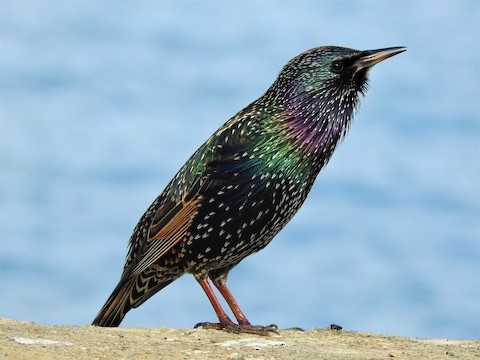Birdfinding.info ⇒ One of the world’s most abundant and familiar birds, and widely regarded as one of the few true avian pests: an invasive species that displaces many native species, a large-scale consumer of various crops, and a prodigious generator of fecal precipitation around its winter roosting sites. Ubiquitous in settled areas of Europe, North America, eastern Australia, New Zealand, southern South Africa, and many oceanic islands of the North Atlantic and South Pacific.
European Starling
Sturnus vulgaris
Native to western and central Eurasia; introduced to North and South America, South Africa, Australia, New Zealand, and various islands. A habitat generalist that thrives in various semiopen, open, and mixed habitats, including cities, towns, and agricultural areas.
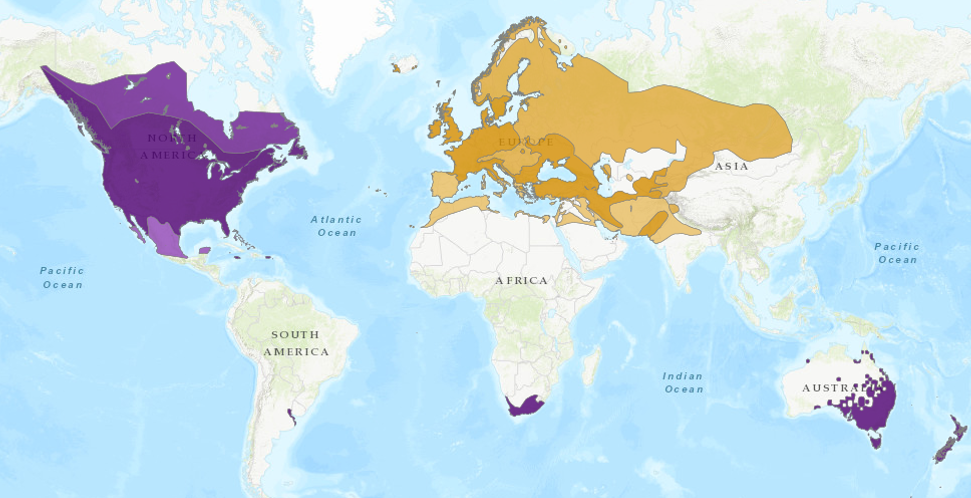
Approximate global distribution of the European Starling (natural range shown in orange). © BirdLife International 2019
Breeding. Natural breeding range extends from Iceland and the Azores east to the Lake Baikal region, including almost all of Europe from northern Scandinavia to the Mediterranean islands (but limited on Iberian Peninsula), and locally south in Asia to southern Pakistan and western India (to Gujarat).
Nonbreeding. In winter it withdraws from far northern Europe and much of central Asia, concentrating in huge flocks in various parts of Europe. Small numbers move farther south into North Africa, Mesopotamia, India, Bangladesh, and elsewhere in southwestern Asia. Smaller numbers winter in East Asia, mainly in the north-coastal lowlands of China, but regularly to Japan, Taiwan, Thailand, etc.

Breeding Bird Abundance Survey: European Starling. © U.S. Geological Survey 2015
Introductions. Introduced populations are established in the temperate zones of each of the remaining continents (North and South America, Africa, and Australia), and on several oceanic islands.
In North America, reportedly introduced in 1890 in New York City, and by the 1980s it occupied the entire continent. Breeds from central and south-coastal Alaska (including Kodiak Island) east across most of Canada to Labrador and Newfoundland, and south throughout the contiguous 48 states to central Mexico (to Cabo San Lucas, Jalisco, Puebla, and Tamaulipas). Breeding populations are also well-established on Bermuda and Jamaica. In winter it generally withdraws from the arctic and subarctic regions and expands southward into Mexico and the northern Bahamas (Grand Bahama, Abaco, Andros, and New Providence).
In Australia, well-established across most of the eastern half, north along the coast to northern Queensland, west along the coast to western South Australia, generally throughout the interior of New South Wales and Victoria, and more thinly in central and southwestern Queensland and northeastern South Australia. Also established on Tasmania, throughout New Zealand’s North and South Islands, and most of the associated islands, including: Kangaroo, the Bass Strait islands, Lord Howe, Norfolk, Chatham, Antipodes, Auckland, Campbell, and Macquarie. Elsewhere in Polynesia, apparently established only on Tonga.
In southern Africa, well-established across much of South Africa, having spread from an initial introduction at Cape Town. Widespread in the coastal lowlands north to southernmost Namibia and KwaZulu-Natal. Local in the interior of South Africa mainly around eastern Lesotho and the Johannesburg-Pretoria area.
In South America, well-established in central Argentina and Uruguay west to Córdoba and south to Bahía Blanca. Expanding rapidly to the west and south—with records increasing from Mendoza, San Luis, La Pampa, and Neuquén—and more slowly northward (first Brazilian records from Rio Grande do Sul in 2017).
Identification
The archetypal starling: a plump, mid-sized songbird with a long, thin, daggerlike bill. One of the most familiar birds of Europe and North America.
Breeding plumage is mostly blackish glossed with green, purple, and blue. The tips of most feathers have a pale buffy or white spot or chevron.
The bills of breeding adults are mostly yellow and the feet are pink. The bills of breeding males typically have a bluish base, while those of females are essentially all-yellow.
Breeding females also differ from breeding males in having more heavily spotted plumage at the equivalent stage of feather-wear.

European Starling, male in breeding plumage. (Libertyville, Illinois; April 15, 2013.) © janetandphil

European Starling, male in breeding plumage. (Whitefish Point, Michigan; April 27, 2019.) © Don Danko

European Starling, male in breeding plumage. (David Gareji Monasteri, Kakhet’i, Georgia; April 18, 2018.) © Luis Mario Arce
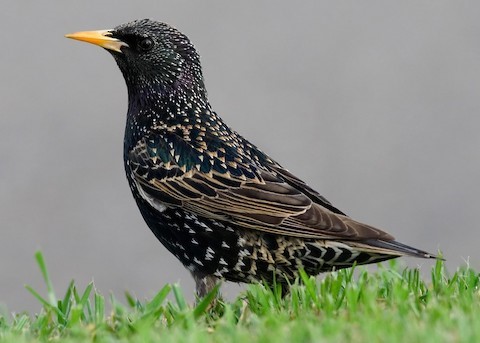
European Starling, female in breeding plumage—all-yellow bill and significantly spotted plumage during breeding season indicate that this is a female. (Chet Holtfield Federal Building, Laguna Niguel, California; March 7, 2007.) © Patrick VanThull
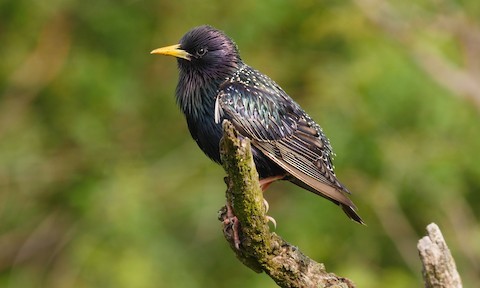
European Starling, female in breeding plumage, showing all-yellow bill and purplish gloss on head. (Ognyanovo, Dobrich, Bulgaria; May 18, 2019.) © Josep del Hoyo
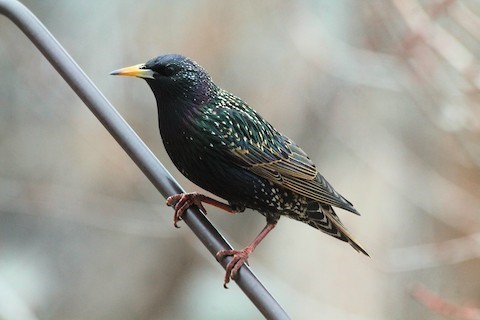
European Starling, male in breeding plumage. (Arvada, Colorado; March 2, 2019.) © Lorraine Lenning

European Starling, male in breeding plumage. (Umatilla, Oregon; April 1, 2020.) © Mark Ludwick
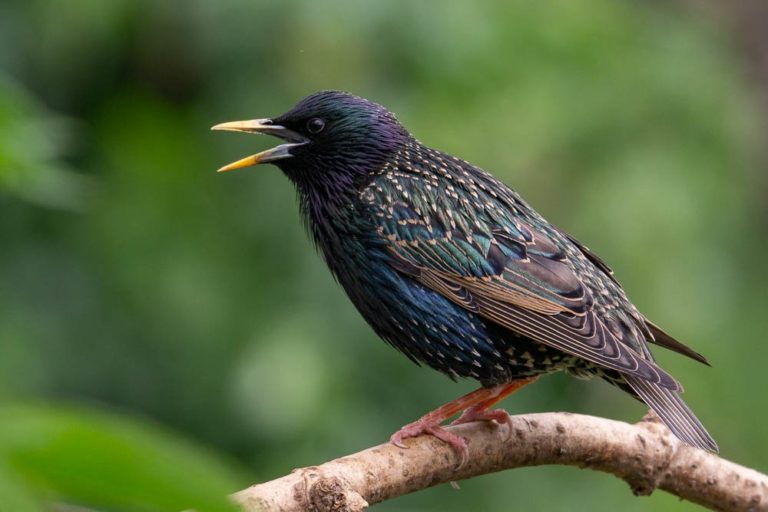
European Starling, male in breeding plumage. (London, England; May 20, 2016.) © Fran W.
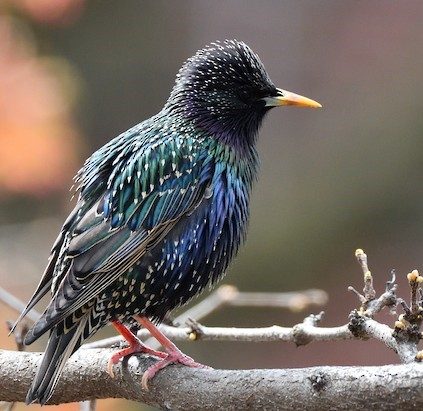
European Starling, breeding plumage, showing greenish and purplish gloss. (Philadelphia, Pennsylvania; April 5, 2020.) © Adam Zahm

European Starling, male in breeding plumage. (Zadonets’ke, Kharkivs’ka Oblast, Ukraine; April 12, 2020.) © Kostyantyn Grinchenko
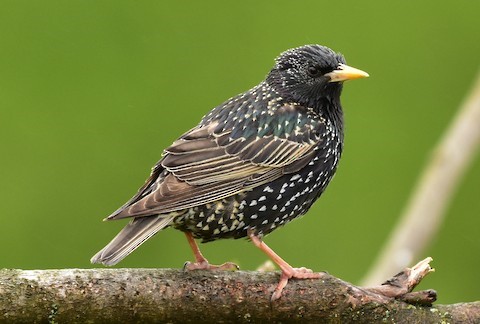
European Starling, female in breeding plumage—note all-yellow bill. (Starksboro, Vermont; May 24, 2019.) © Henry Trombley
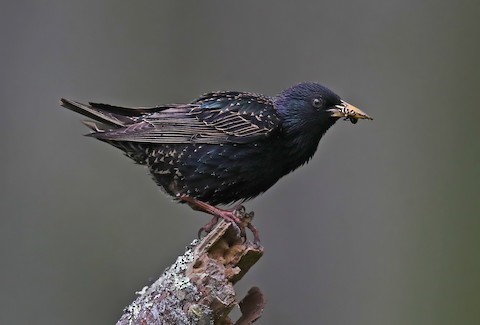
European Starling, female in breeding plumage, carrying prey in bill. (Estero Trail, Point Reyes National Seashore, California; May 12, 2018.) © Matt Davis

European Starling, male in breeding plumage. (Patterson Park, Baltimore, Maryland; May 16, 2015.) © Simon Best
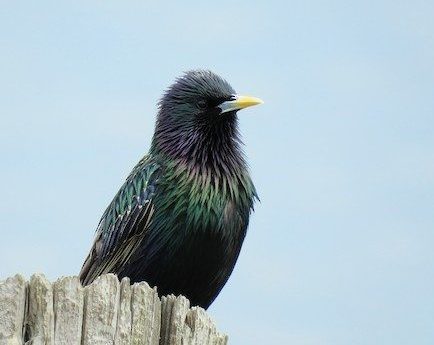
European Starling, male in breeding plumage with few noticeable spots. (DuPont Nature Center, Slaughter Beach, Delaware; May 5, 2018.) © Mike Hudson

European Starling, female in breeding plumage. (Rotary Marsh, Kelowna, British Columbia; March 31, 2019.) © Nick Swan

European Starling, male in breeding plumage, showing a rainbow sheen. (Salmon, Idaho; February 19, 2018.) © Marsha White
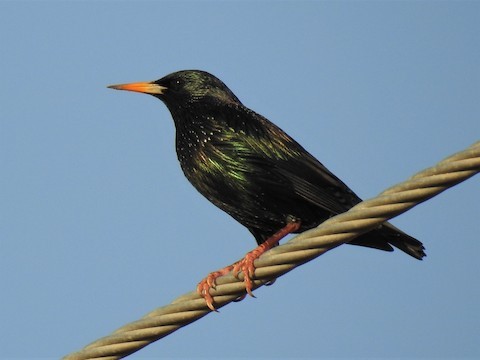
European Starling, apparently a female in breeding plumage—possibly S. v. porphyronotus, which breeds in central Asia and has very limited spotting. (Banyan Fodder Field, Ra’s al-Khaimah, United Arab Emirates; February 29, 2020.) © Stephen Taylor

European Starling, male in breeding plumage, showing purplish gloss and very limited spotting. (Lake Temescal, Oakland, California; March 26, 2019.) © Gail West
Nonbreeding plumage is similar to breeding but with much larger spots.
The spots appear during the post-breeding moult, and they erode away through feather-wear until the following breeding season.
The bills of nonbreeding birds are blackish, and the legs are dark red.

European Starling, nonbreeding. (Stilesboro, Georgia; November 25, 2016.) © Dan Vickers
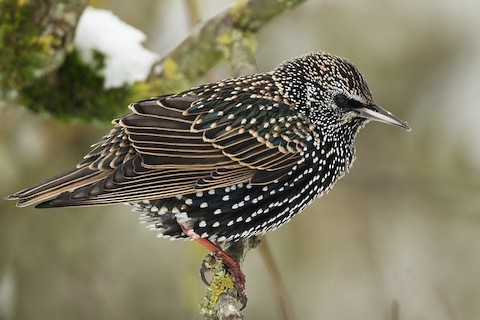
European Starling, nonbreeding. (La Sologne, France; December 1, 2010.) © Frédéric Pelsy
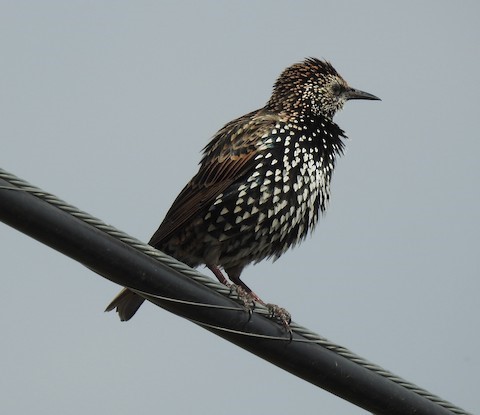
European Starling, nonbreeding. (Redlands Parkway Ponds, Grand Junction, Colorado; September 9, 2017.) © Glenn Pearson
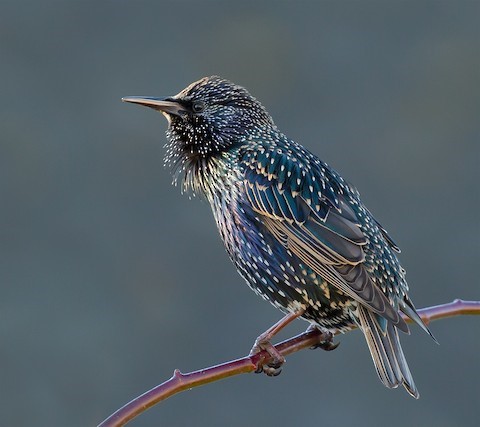
European Starling, nonbreeding. (Kockengen, Utrecht, Netherlands; November 28, 2016.) © Jieles van Baalen
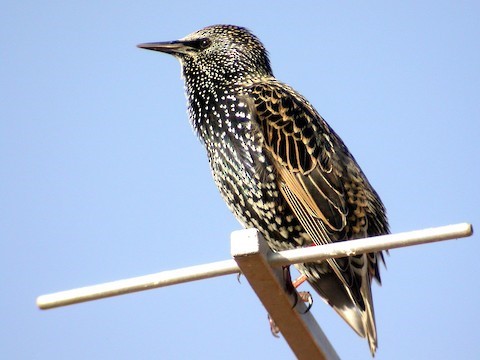
European Starling, nonbreeding. (Azud de Riolobos, Salamanca, Castilla y León, Spain; November 6, 2003.) © Miguel Rouco
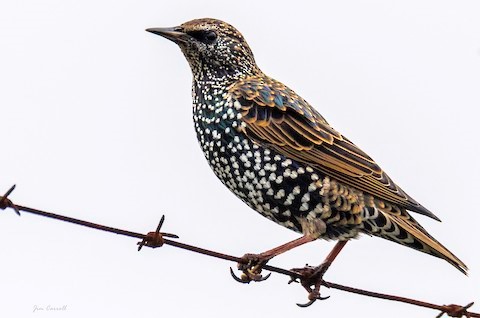
European Starling, nonbreeding. (Marsh Creek, Saint John, New Brunswick; October 4, 2018.) © Jim Carroll

European Starling, nonbreeding. (Point Pinos, Pacific Grove, California; December 5, 2017.) © Paul Fenwick
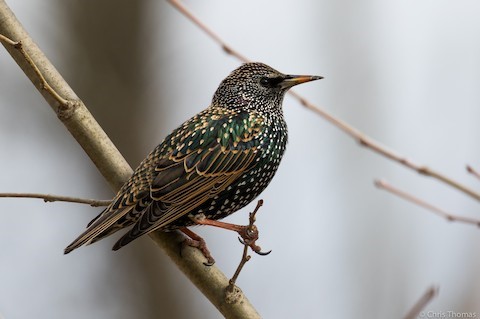
European Starling, nonbreeding. (Great Swamp National Wildlife Refuge, New Jersey; January 27, 2019.) © Chris Thomas

European Starling, nonbreeding—but note mostly yellow bill. (Liberty Island, New York; December 5, 2019.) © Samuel Burckhardt

European Starling, nonbreeding—note extensively white face. (Faro Punta Carretas, Montevideo, Uruguay; April 13, 2019.) © Natalia Villar

European Starling, moulting into nonbreeding plumage—head feathers not yet moulted. (Karrendorfer Wiesen, Mecklenburg-Vorpommern, Germany; August 21, 2010.) © Christoph Moning
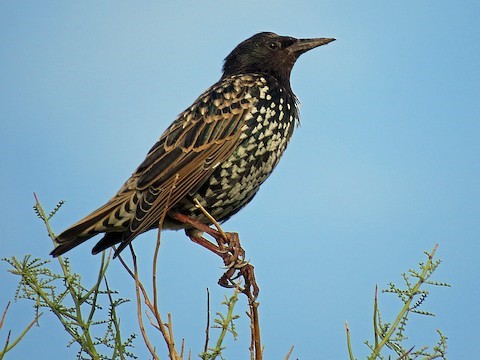
European Starling, moulting into nonbreeding plumage—head feathers not yet moulted. (Sacaton Sewage Treatment Plant, Sacaton, Arizona; October 9, 2018.) © David Pearson
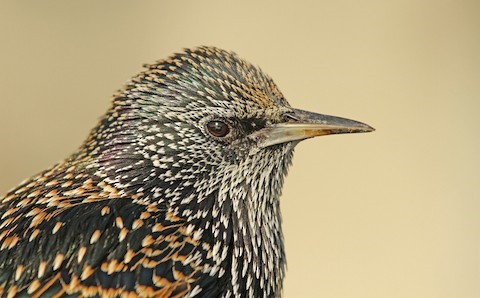
European Starling, close-up view of fresh nonbreeding plumage. (Castle Island, Boston, Massachusetts; November 14, 2012.) © Ryan Schain

European Starling, frontal view of open bill. (Castle Island, Boston, Massachusetts; November 14, 2012.) © Ryan Schain

European Starling, nonbreeding plumage with white spots predominating underparts. (Castle Island, Boston, Massachusetts; December 16, 2018.) © Ryan Schain

European Starling, nonbreeding. (Lake St. Clair Metropark, Harrison Charter Township, Michigan; November 15, 2019.) © Andrew Simon

European Starling, male in nonbreeding plumage with strikingly rusty wings. (Lake Hemet, California; December 2, 2019.) © Greg Cross
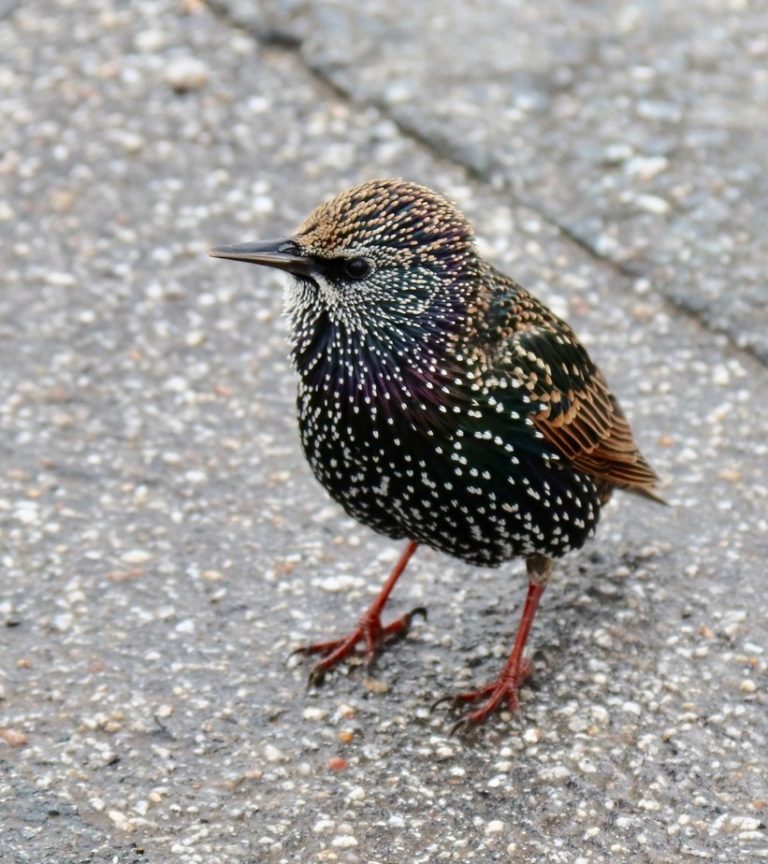
European Starling, nonbreeding. (Penzance, England; October 13, 2019.) © nzoo
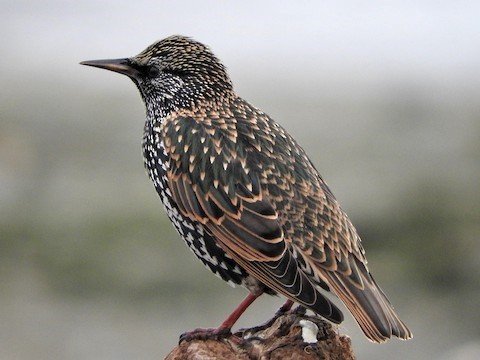
European Starling, nonbreeding. (Esquimalt Lagoon, British Columbia; November 29, 2018.) © Gerald McKeating
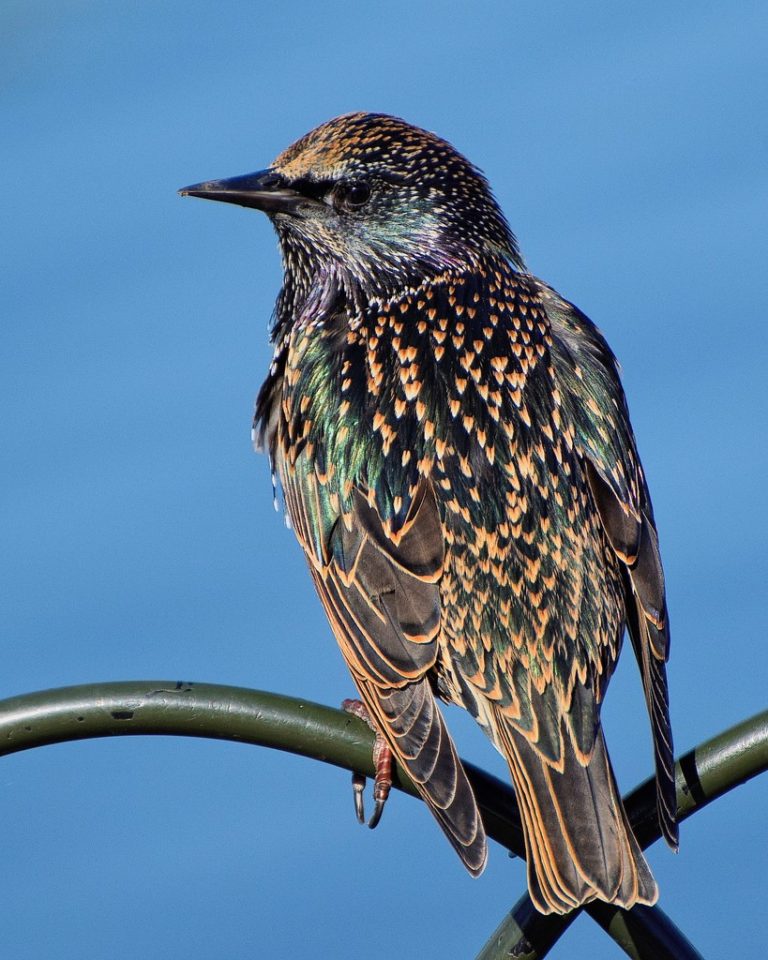
European Starling, nonbreeding, dorsal view. (London, England; September 25, 2018.) © Frank Sengpiel
Immatures are mostly brown, usually with blackish lores, blurry streaking on the breast, and warm, rusty tones on the wings.
The bill is black and the legs are usually dull reddish-brown.
The overall coloration of immatures is typically a medium grayish-brown, but it varies widely: from sandy to sooty and from cold-gray to warm-brown.

European Starling, immature with typically grayish-brown plumage, blackish lores, and blurry streaks on the breast. (Esquimalt Lagoon, British Columbia; July 11, 2019.) © Les Peterson
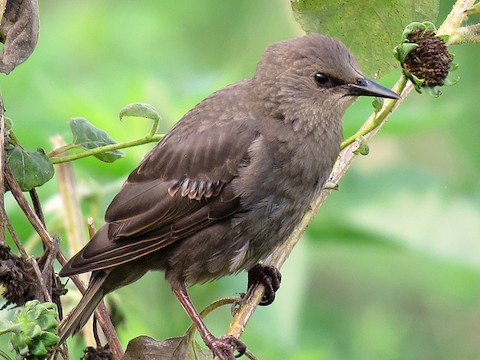
European Starling, immature with typically grayish-brown coloration—note emerging wing coverts. (White Oak Bayou, Houston, Texas; May 21, 2016.) © Wendy Wright

European Starling, immature with sooty gray-brown plumage. (Muirhead, South Ayrshire, Scotland; May 22, 2014.) © Bruce Kerr
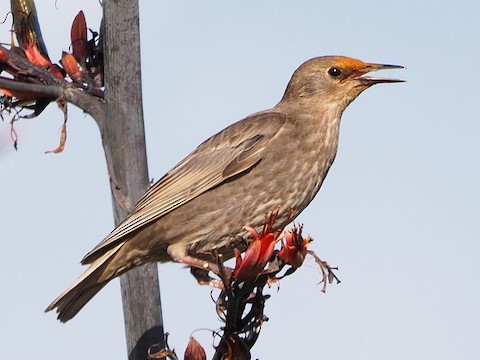
European Starling, immature with pale sandy coloration and an apparent stain on the forehead. (Waikanae Estuary, Kapiti Coast District, North Island, New Zealand; January 12, 2019.) © Sue North
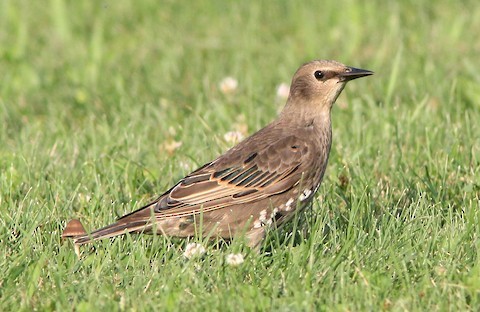
European Starling, beginning to moult from pale sandy immature plumage into nonbreeding plumage. (Finger Lakes Community College, Wayne County, New York; July 27, 2017.) © Dave Spier
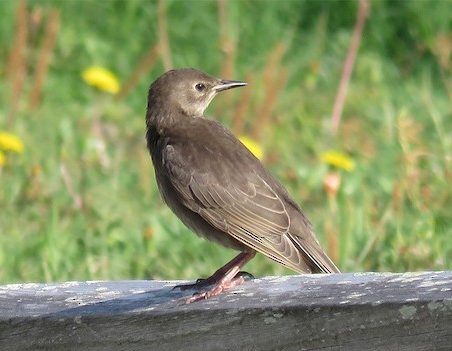
European Starling, immature with extremely drab grayish-brown coloration. (Waves, Hatteras Island, North Carolina; May 20, 2017.) © Karen Lebing
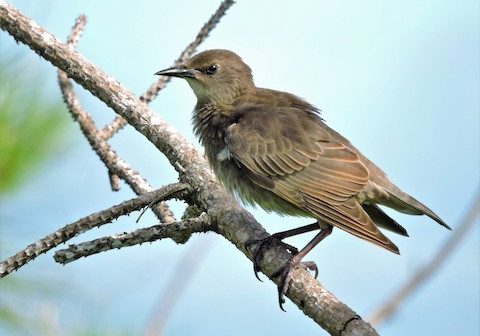
European Starling, immature with typically drab, medium grayish-brown coloration. (Ritch Grissom Memorial Wetlands, Melbourne, Florida; June 26, 2017.) © S.K. Jones

European Starling, immature with mostly warm-brown coloration. (Moscow, Russia; July 6, 2019.) © sokolkov2002

European Starling, immature with mostly warm-brown plumage. (Augusta Lake, Kansas; May 29, 2017.) © Suntesha Wustrack
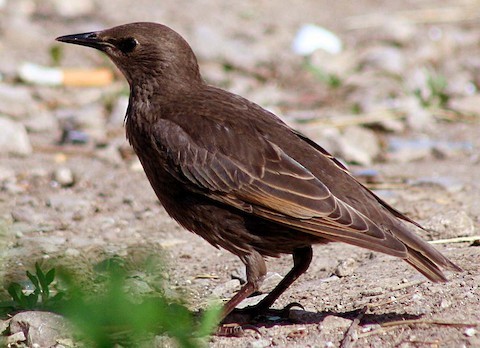
European Starling, immature with dark warm-brown coloration. (Ulianovsliy Park, Moscow, Russia; June 9, 2007.) © Vladimir Deryabin
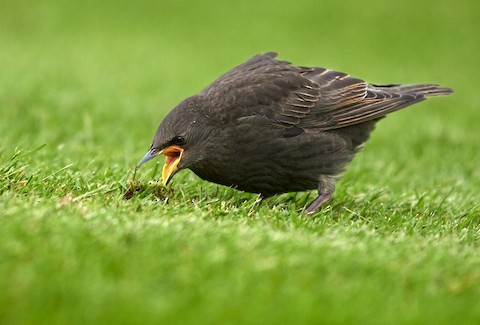
European Starling, immature with sooty gray-brown plumage. (Reykjavík, Iceland; June 29, 2017.) © Tomas Grim
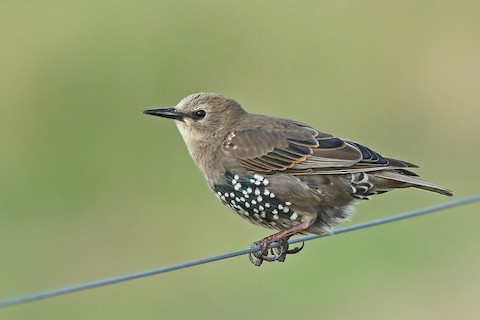
European Starling, moulting from typical immature into nonbreeding plumage. (Katinger Watt, Schleswig-Holstein, Germany; August 3, 2019.) © Volker Hesse
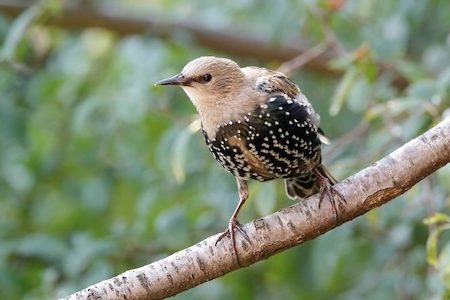
European Starling, moulting from extremely pale sandy immature plumage into nonbreeding plumage. (Braunschweig, Dibbesdorf, Niedersachsen, Germany; September 10, 2019.) © Holger Teichmann
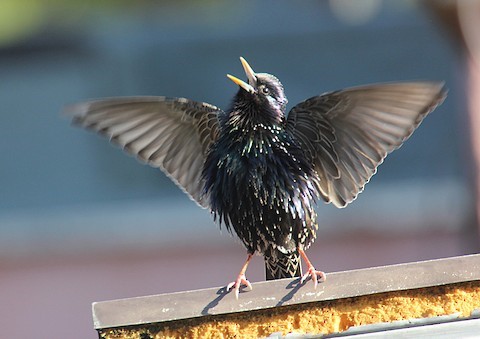
European Starling, stretching and showing distinctive triangular wing shape. (Bioparco, Lazio, Italy; March 27, 2012.) © Raniero Massoli Novelli
The flight silhouette is distinctive: short-bodied, long-billed, and square-tailed, with pointed, triangular wings.
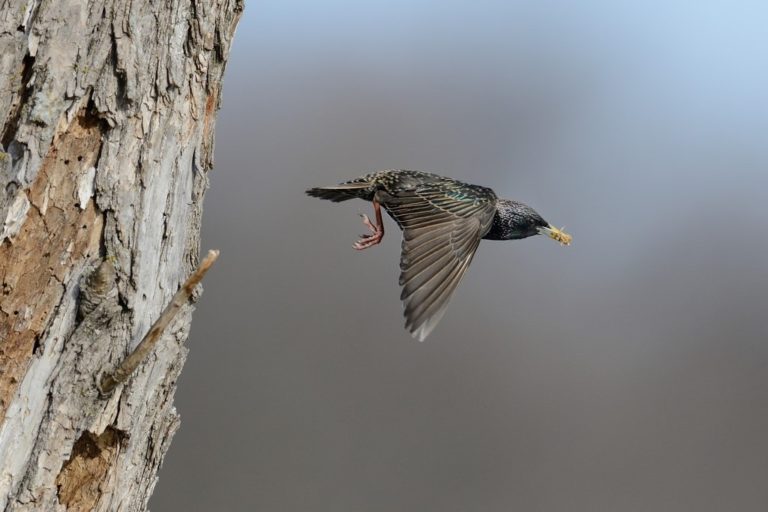
European Starling, breeding male in flight, showing triangular wing shape. (Libertyville, Illinois; April 15, 2013.) © janetandphil

European Starling, showing flight silhouette. (Valencia, Spain; February 10, 2020.) © Luis Orlando
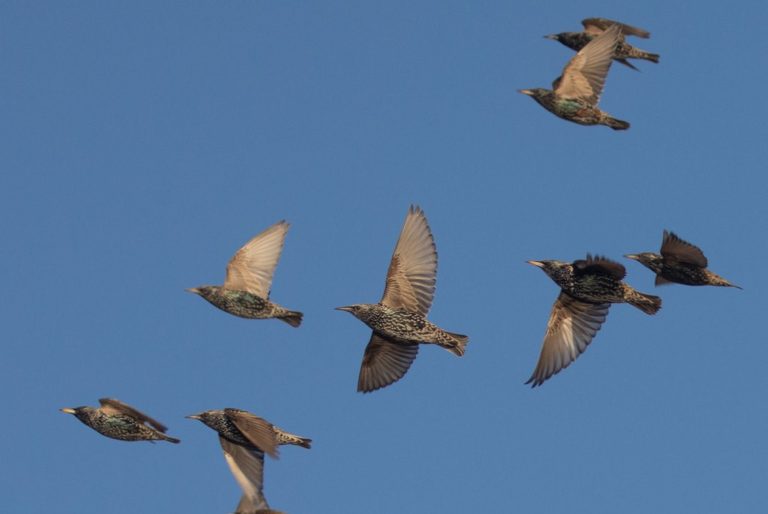
European Starlings, showing various flight silhouettes. (Valencia, Spain; February 10, 2020.) © Luis Orlando

European Starling, showing flight silhouette, wings up. (Fairless Landfill, Tullytown, Pennsylvania; December 16, 2017.) © Tom Johnson

European Starling, showing flight silhouette, wings horizontal. (Fairless Landfill, Tullytown, Pennsylvania; December 16, 2017.) © Tom Johnson

European Starling, showing flight silhouette, wings down. (Fairless Landfill, Tullytown, Pennsylvania; December 16, 2017.) © Tom Johnson

European Starling with wings and tail fanned. (Union Reservoir, Longmont, Colorado; April 17, 2018.) © Steven Mlodinow
Cf. Spotless Starling. European and Spotless Starlings overlap widely in southwestern Europe and are potentially confused in some plumages. European is far more heavily spotted at all equivalent stages of moult and feather-wear, but freshly moulted Spotless can be spotted at approximately the same density as pre-moult European.
In cases of closest similarity between them, Spotless differs from European in two principal ways: (1) its spots are uniformly small, dull, and evenly distributed across the underparts—typically none visible on the upperparts; (2) its black plumage shows only a slight gloss, usually a colorless sheen that sometimes has a purplish cast, or less often greenish.
Immatures of the two species can be very similar. As a general rule of thumb, immature Spotless is a darker, sootier shade of grayish-brown, and has a relatively indistinct darker lore. Variation within both species is probably sufficient to make some immatures unidentifiable.
Notes
Polytypic species consisting of thirteen recognized subspecies.
References
Alderfer, J., and J.L. Dunn. 2014. National Geographic Complete Birds of North America (Second Edition). National Geographic Society, Washington, D.C.
BirdLife International. 2019. Sturnus vulgaris. The IUCN Red List of Threatened Species 2019: e.T22710886A137493608. https://dx.doi.org/10.2305/IUCN.UK.2019-3.RLTS.T22710886A137493608.en. (Accessed May 2, 2020.)
Brazil, M. 2009. Birds of East Asia. Princeton University Press, Princeton, N.J.
Craig, A., and C. Feare. 2020. Common Starling (Sturnus vulgaris). In Handbook of the Birds of the World Alive (J. del Hoyo, A. Elliott, J. Sargatal, D.A. Christie, and E. de Juana, eds.). Lynx Edicions, Barcelona. https://www.hbw.com/node/60851. (Accessed May 2, 2020.)
eBird. 2020. eBird: An online database of bird distribution and abundance. Cornell Lab of Ornithology, Ithaca, N.Y. http://www.ebird.org. (Accessed May 2, 2020.)
Feare, C., A. Craig, B. Croucher, C. Shields, and K. Komolphalin. 1999. Starlings and Mynas. Princeton University Press, Princeton, N.J.
Garcia-del-Rey, E. 2011. Field Guide to the Birds of Macaronesia: Azores, Madeira, Canary Islands, Cape Verde. Lynx Editions, Barcelona.
Hollom, P.A.D., R.F. Porter, S. Christensen, and I. Willis. 1988. Birds of the Middle East and North Africa. T & AD Poyser, Calton, England.
Howell, S.N.G., and S. Webb. 1995. A Guide to the Birds of Mexico and Northern Central America. Oxford University Press, Oxford.
Mullarney, K., L. Svensson, D. Zetterström, and P.J. Grant. 1999. Birds of Europe. Princeton University Press, Princeton, N.J.
Robson, C. 2002. Birds of Thailand. Princeton University Press, Princeton, N.J.
Sibley, D.A. 2000. The Sibley Guide to Birds. Alfred A. Knopf. New York.
Sinclair, I., P. Hockey, W. Tarboton, and P. Ryan. 2011. Birds of Southern Africa (Fourth Edition). Random House Struik (Pty) Ltd. Cape Town, South Africa.
Xeno-Canto. 2020. Common Starling – Sturnus vulgaris. https://www.xeno-canto.org/species/Sturnus-vulgaris. (Accessed May 2, 2020.)
